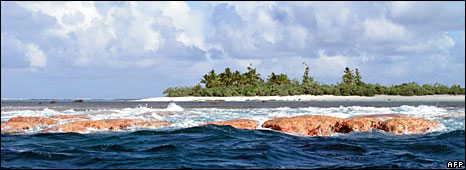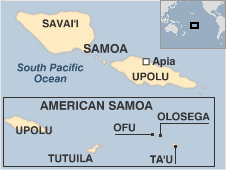
The low-lying parts of the Pacific islands have been vulnerable to storm damage
The Samoan islands that have been struck by tsunamis are divided between independent Samoa and the US territory of American Samoa. The overall population of the islands, which lie in the central South Pacific, is about 250,000. Samoa, which changed its name from Western Samoa in 1997, has deep ties to New Zealand and is known by many for its rugby team. American Samoa, where residents are US nationals but not citizens, has strong economic links to the US.
The territories share Samoan language and customs, are overwhelmingly Christian, and their economies revolve around fishing and agriculture - vulnerable in the past to natural disasters. In both, the same extended family networks headed by an elected chief have survived. However, the islands have been split since the colonial period, when the trade in coconut oil and the opportunity to secure a naval base in the area made them a target as Western imperial powers and Japan vied for influence in the Pacific and China. In 1899, a treaty divided the archipelago between Germany and the US. Driving switch Independent Samoa comprises the much larger, western islands. The territory was ruled by New Zealand after World War I, before voting to become the first Polynesian island to obtain independence in 1962. Of a population of some 190,000, 99% live on the largest of nine volcanic islands Savai'i and Upolu, and more than 100,000 Samoans live in New Zealand.
 |
SAMOAS TIMELINE
1899: Archipelago split between US and Germany
1914: New Zealand occupies Western Samoa
1951: US navy's direct control of American Samoa ends
1962: Western Samoa gains independence
1997: Western Samoa changes name to Samoa
|
It has been a member of the Commonwealth in 1970. Recently, Samoa was in the news for becoming the first country since the 1970s to change the side of the road on which cars are driven. It switched from right to left, partly to end dependence on costly, left-hand drive imports from the US. The economy centres on agriculture and fishing, though there has been some successful diversification into tourism - which accounts for about 25% of gross domestic product - as well as offshore banking and light manufacturing. Foreign aid and family remittances have also been important. Politically Samoa is a parliamentary democracy, though socially it remains conservative and devoutly Christian. In the past, many young Samoans have migrated to New Zealand, American Samoa and the US. The decision to change the country's name from Western Samoa to Samoa stirred protests in the American part of the archipelago. Canned tuna The eastern islands were first occupied by the US in 1898, and US influence was consolidated by a large marine presence in World War II. The islands are now the country's furthest flung territory. Residents are US nationals rather than citizens, meaning they cannot vote in national elections or be drafted, though they do have free entry to the US. Tens of thousands live in the states of California and Washington, and an estimated 20,000 in Hawaii, 2,300 miles north-east. There is a local government organised on the federal model, and one non-voting member is sent to the US House of Representatives. Some 95% of the territory's population of more than 60,000 lives on the largest island, Tutuila. Tuna fishing accounts for much of American Samoa's economy, and more than 90% of exports are in canned tuna.
|








Bookmark with:
What are these?